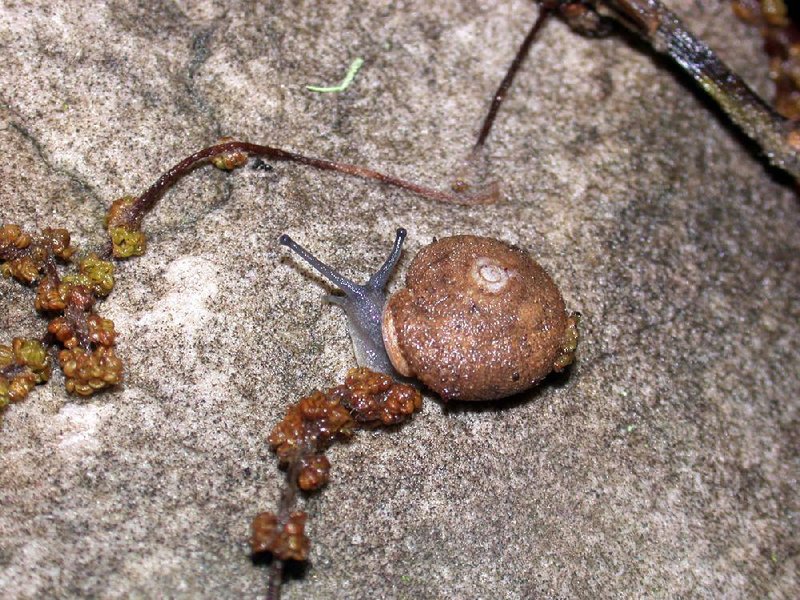MAGAZINE — The U.S. Fish & Wildlife Service wants to remove the Magazine Mountain shagreen snail from the endangered species list, saying its population is stable and threats have been averted.
If that happens the snail, which lives only on Magazine Mountain, would be the first invertebrate to be “delisted” under the Endangered Species Act of 1973.
The Magazine Mountain shagreen, Inflectarius magazinensis, lives on north and west slopes above an elevation of 2,200 feet on the 2,753-foot-tall mountain, which is the highest point in Arkansas. Its habitat includes 27 slopes on 22 acres of land on the mountain.
It has a brown shell with the texture of sharkskin and grows to a width of a 1/2 inch, said Ronald Caldwell, a professor of biology at Lincoln Memorial University in Harrogate, Tenn., who is an expert on the snail.
Caldwell said removing the snail from the list would be “a success story” reflecting the efforts of several state and federal agencies, along with the university, to preserve the snail’s habitat.
The Magazine Mountain shagreen was added to the list in 1989, mainly because of three threats, but thosethreats have been avoided and the snail’s population has been stable for 16 years, said Chris Davidson, U.S. Fish & Wildlife Service team leader for the endangered species program in Arkansas.
Davidson said it’s impossible to get an exact count on the number of snails on Magazine Mountain. The population was determined to be stable because some of the snails could be found each year between April and mid-June, he said. After that point, the snail spends most of its time underneath rocks or deep in the talus, a sloping mass of rock fragments at the foot of a cliff, where it’s cool and moist.
The threats in the 1980s included proposed militarytraining on the mountain, construction of Mount Magazine State Park and Lodge, and land use management practices by the U.S. Forest Service.
The U.S. Army withdrew its plan for training on the mountain. The lodge was constructed on the south side of the mountain, away from the snail’s habitat. And special management practices were implemented to protect the snail’s habitat, Davidson said.
The snail often feeds on catkins that drop from oak trees, Caldwell said. That’s in addition to algae that snails scrape from rocks.
“When magazinensis came into question [it] was pre-state park,” Caldwell said. “There wasn’t anything there but an overlook and some ruins from what existed there before.”
A two-story lodge with 26 guest rooms built by theWorks Progress Administration was completed in 1940. It was destroyed by fire in 1971. A new 126,000-square-foot lodge was built from 2004-2006. It has 60 guest rooms and 13 cabins.
A special-use permit was signed in 1998 creating Mount Magazine State Park. Afterconstruction of roads, utilities, campgrounds, a visitor’s center and other facilities, Mount Magazine State Park was officially dedicated in 2002.
“We had to alleviate those three threats, and the population had to be stable for at least 10 years,” said Davidson.
Other shagreen snails, Inflectarius edentatus, live in the Boston Mountains and on Petit Jean Mountain and Mount Nebo in Arkansas, but the Magazine Mountain shagreen is different, said Davidson.
Caldwell said the differences can’t be seen with the naked eye.
“They’re going to look the same on the outside, but there are good internal differences and anatomical differences,” he said. “Biologists like that kind of thing because you can see evolution in action. It must have originated fromedentatus. ... Evolution did it’s thing.”
One of the main differences is “terminal genitalia,” he said. In this case, the snail’s penis. Most snails are hermaphroditic.
“The morphology of the terminal genitalia is different in both of them,” said Caldwell, referring to the two types of Arkansas shagreen snails.
The Fish & Wildlife Service is working to recover about 600 species from the endangered list. About a third of them are invertebrates, Davidson said.
The Forest Service owns Magazine Mountain. The Arkansas Department of Parks and Tourism has a long-term special-use permit to operate a state park on the summit.
The Forest Service also is conducting annual surveys of the Magazine Mountain shagreen’s population and worked with the Arkansas Game and Fish Commission and the Fish & Wildlife Service to fund history and ecology research, according to a news release.
If the Magazine Mountain shagreen is removed from the Federal List of Endangered and Threatened Wildlife and Plants, federal agencies will no longer need to consult with the Fish & Wildlife Service to ensure things they do on the mountain won’t jeopardize the continued existenceof this species, according to the release.
The Fish & Wildlife Service will continue to work with the Forest Service, the Arkansas Department of Parks and Tourism, and the Arkansas Game and Fish Commission to implement a post-delisting monitoring plan for at least five years if the Magazine Mountain shagreen is delisted, the release said.
The public is invited to comment on the proposed delisting until Aug. 20. The Fish & Wildlife Service is seeking comments in particular pertaining to biological information about the species, possible threats to the snail and a plan to protect it after it is removed from the list.
Copies of the proposed rule, which appeared in the Federal Register on June 19, are available at regulations.gov by searching for docket number FWS--R4-ES-2012-0002. A post delisting monitoring plan is also available there. Comments can be left on the web site by clicking the “comment now” button.
Comments also can be mailed to: Public Comments Processing, Attn: No. FWSR4-ES-2012-0002, Division of Policy and Directives Management, U.S. Fish and Wildlife Service, 4401 N. Fairfax Drive, Suite 222, Arlington, Va. 22203.
Northwest Arkansas, Pages 7 on 06/25/2012

